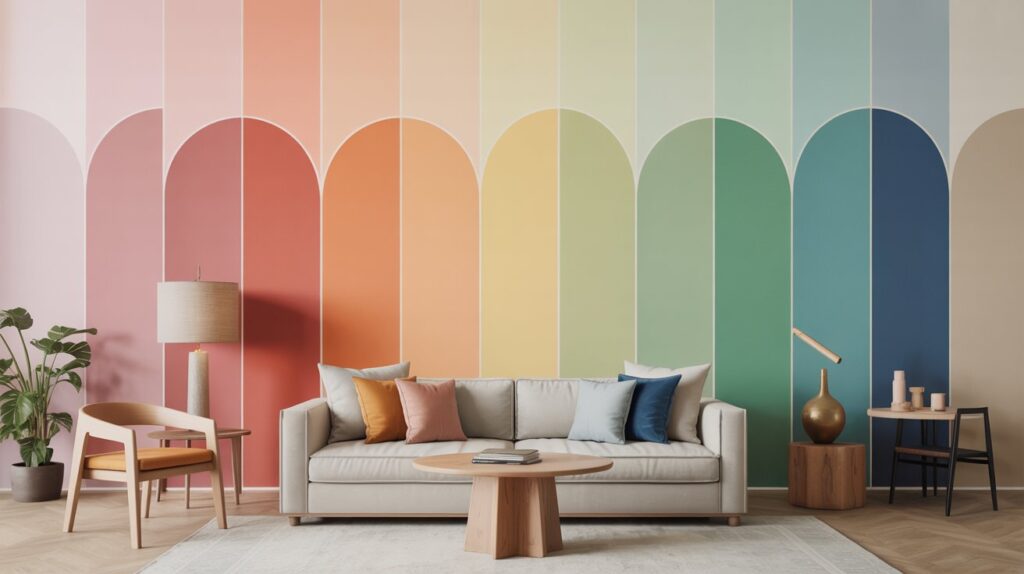I have been, or can be if you click on a link and make a purchase, compensated via a cash payment, gift, or something else of value for writing this post. As an Amazon Associate, I earn from qualifying purchases. Please read my full Affiliate Disclosure for more information.
To create a cohesive look across multiple rooms, start with a unifying color palette anchored by a dominant hue and repeated in upholstery, artwork, and accessories. Repeat key materials and finishes for surfaces and accents, aligning architectural details across spaces. Align furniture silhouettes for rhythm, varying only chair backs and legs to avoid monotony. Layer lighting—ambient, task, and accent—plus dimming to guide flow. Layer accessories in odd numbers to reinforce scale; if you keep going, you’ll uncover how to apply these principles more deeply.
Key Takeaways
- Establish a 3-5 hue color palette anchored by a dominant color for consistency across rooms.
- Repeat core materials and finishes in surfaces and accents to unify the spaces.
- Align furniture silhouettes and scales across rooms to create rhythm and flow.
- Layer lighting (ambient, task, accent) to define zones and guide movement.
- Use layered accessories and scalable decor, grouping items in odd numbers to reinforce cohesion.
Choosing a Unifying Color Palette
A unifying color palette should anchor your spaces while allowing for flexibility across rooms. You’ll establish a core set of hues—three to five tones—anchored by a dominant color and complemented by supporting shades. Consider color psychology: cooler neutrals calm living areas, warmer tones energize kitchens, and muted accents tie bedrooms to a shared mood. Aim for visual continuity by repeating key colors in upholstery, artwork, and accessories rather than walls alone. Balance contrast and harmony with saturation, ensuring lighting enhances the palette. Document your scheme for consistency, and adapt with small refinements as furniture evolves.

Repeating Key Materials and Finishes
To establish coherence throughout the home, repeat key materials and finishes across spaces in a purposeful way. You’ll reinforce a unified feel by layering consistent textures and tones, framing rooms with intentional continuity.
- Choose recurring materials and finishes for surfaces like countertops, floors, and backsplashes to create visible rhythm.
- Tie in decorative accents that echo foundational materials, ensuring subtle repetition without sameness.
- Align architectural details—moldings, fixtures, and hardware—across rooms to unify sightlines.
- Maintain a restrained palette to let finishes speak, avoiding excessive variation that fragments the look.
This approach supports architectural details while keeping the décor refined and coherent.
Aligning Furniture Silhouettes Across Spaces
Aligning furniture silhouettes across spaces creates a clean, deliberate rhythm that guides the eye from room to room. You’ll synchronize scale, profile, and stance so similar forms recur without redundancy, reinforcing a unified feel. Start with a baseline silhouette—sofas or casegoods—then mirror smaller pieces, like chairs or end tables, to balance weight. Consider furniture arrangement that preserves sightlines while preserving functional zones. Vary chair backs and leg styles within that shared profile to avoid monotony, and align arm heights to maintain a coherent appearance along hall, doorway, and room transitions. This disciplined approach supports pattern mixing without visual chaos, ensuring cohesion and flow.
Establishing Layered Lighting for Flow
Establishing layered lighting begins with a clear plan for how each layer supports flow: ambient, task, and accent lighting work together to guide movement, define zones, and highlight key features. You’ll balance brightness and color temperature to maintain a steady ambient glow while avoiding glare. Use fixture styles that complement architectural details and furniture scale to preserve cohesion.
- Map where ambient glow, task, and accent light will reside for seamless progression.
- Choose fixture styles that harmonize with room character and ceiling height.
- Set consistent color temperature across zones to prevent visual jarring.
- incorporate dimming to control mood and circulation cues.
Layering Accessories and Managing Room Scales
Layering accessories effectively hinges on proportion and scale, ensuring decorative elements complement rather than compete with the room’s architecture and furnishings. You’ll translate concept to practice by prioritizing an artful arrangement where each item earns its place. Begin with larger anchors at eye level, then layer smaller accents to create depth without crowding. Group items in odd numbers for rhythm and avoid symmetry that reads flat. Balance color, texture, and shine across zones, and respect clearance around furniture for flow. Use decorative accents to unify palettes, then refine with purposeful repeats to reinforce a cohesive, scalable look throughout the home.
Conclusion
To create a cohesive look across spaces, you’ll implement a unified strategy across color, materials, scale, and lighting. Choose a unifying palette and repeat key finishes to anchor rooms. Align furniture silhouettes for a continuous rhythm, and layer lighting to guide flow without glare. Layer accessories thoughtfully, ensuring scale complements each space. When in doubt, reference your core elements, applying them with measured consistency to maintain harmony while preserving the unique function and character of every room.

Leave a Reply